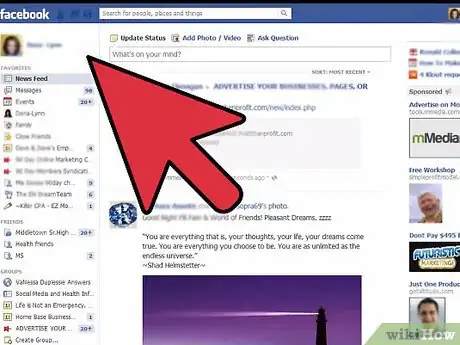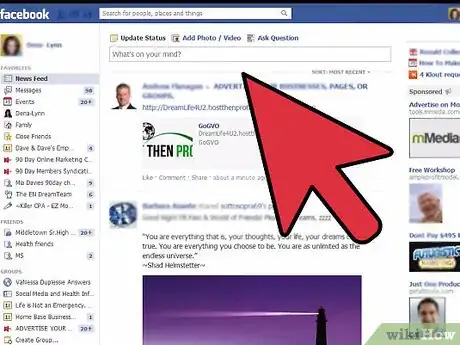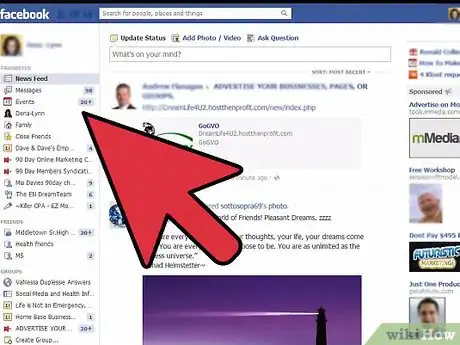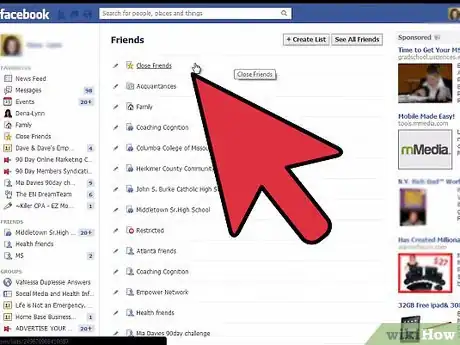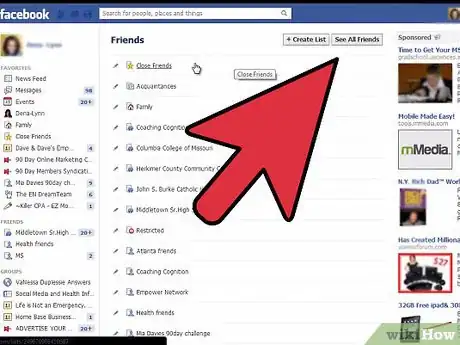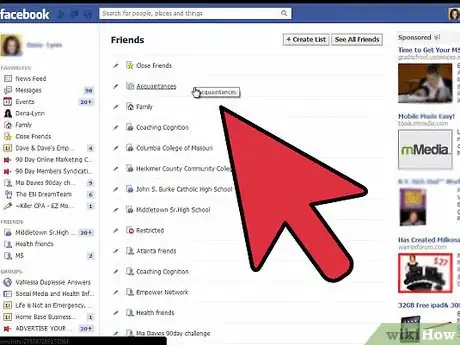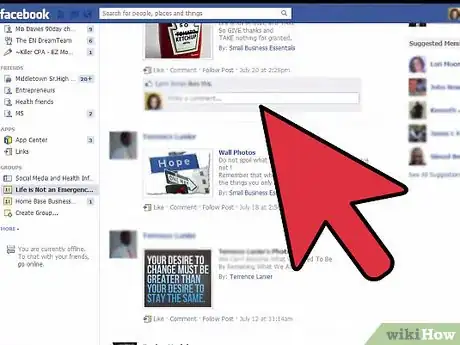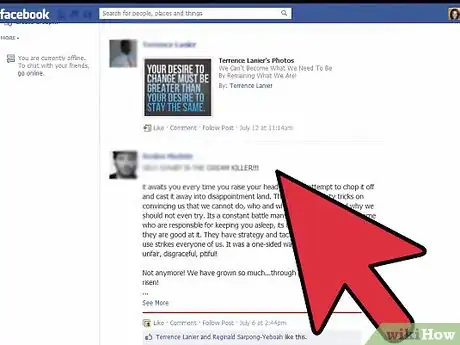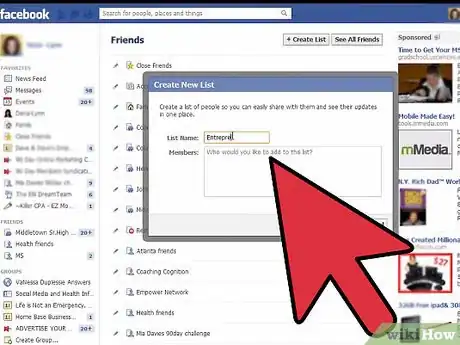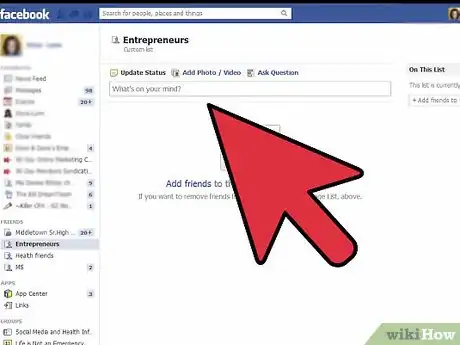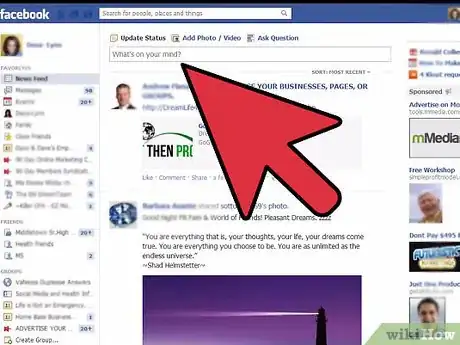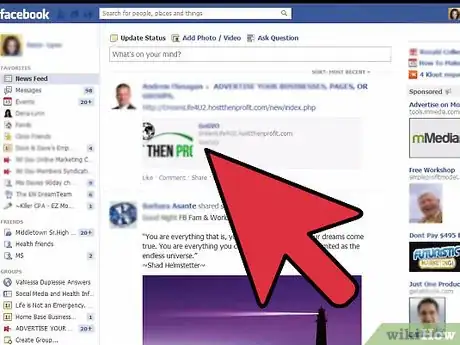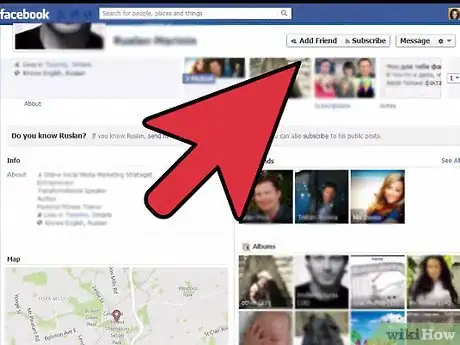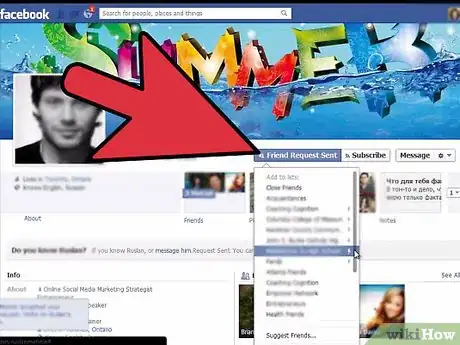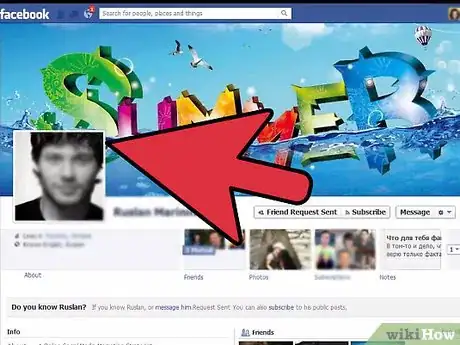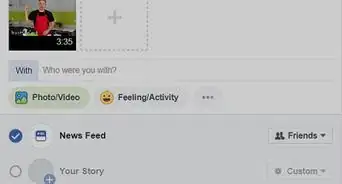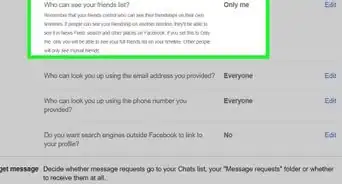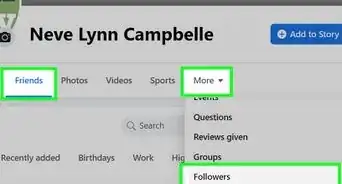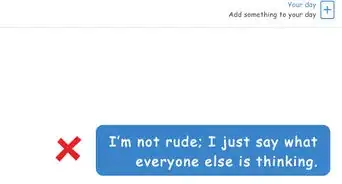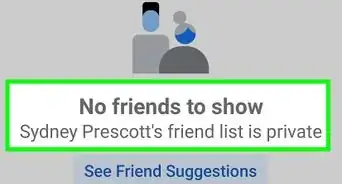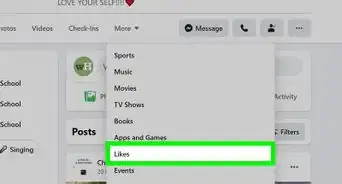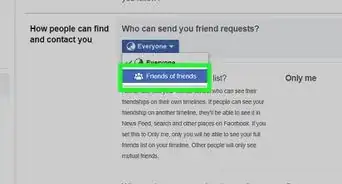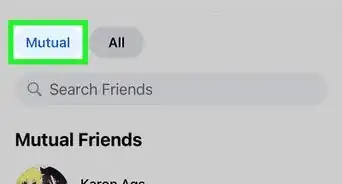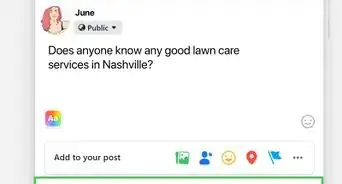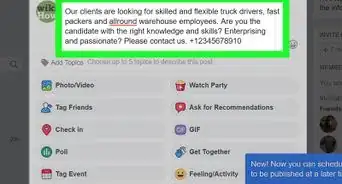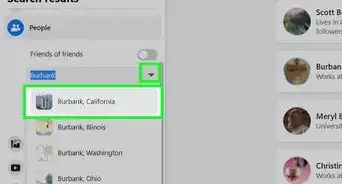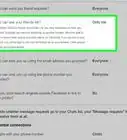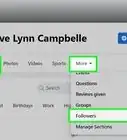This article was co-authored by Isabelle Garson. Isabelle Garson is a Social Media Expert based in the San Francisco Bay Area. With 10 years of experience, she works in social media strategy and content production. She specializes in music and cannabis marketing and has worked with international touring artists. Isabelle studied graphic design at the Academy of Art University. Additionally, she holds a certification from Sprinklr Research Analyst Pro.
This article has been viewed 236,101 times.
You can never have enough friends, be it online or in real life. By using online social media tools like Facebook, and making smart choices about what type of information you put on your profile, as well as how you communicate with your online presence, you can create a large network of old and new online friends.
Steps
Creating an Appealing Profile
-
1Use a profile picture that shows your face, preferably smiling. Your Facebook profile image and your cover image are the first things people looking at your page will see, so make them visually appealing and approachable.[1]
- When choosing a profile picture, look for one that shows off your smile, your eyes, or a moment where you look expressive and friendly.
- Add photos with interesting textural backgrounds like an art gallery or beautiful gardens.
- Avoid using logos or brands as your profile picture, as this may appear you are a spam page or trying to sell something to people who become friends with you.
- Try not to use a picture of your pet or a group shot of you with others, as this could make it hard for someone to know who they are becoming friends with.
- Your cover image (the large image at the top of your Facebook profile) should also be approachable and personal. It could show a collage of other pictures of you or one bold image that conveys you as a whole.
-
2Fill in your About page with details that are appropriate, but not too much information. When you fill in your About your page, just keep in mind all of your friends will be reading this information about you. So keep it personal without being so personal it turns anyone off or becomes too much information for the public forum of Facebook.[2]
- Putting down your interests, your favorite movies, and your favorite books in your About page will give someone a better sense of what you enjoy and whether you would be a good fit as a friend, but keep in mind these are considered "extras" on your profile and are not required to set up a Facebook profile page.
- Be aware that Facebook sells your information to marketing groups and third parties, who will then use the data to better market products to you. So be cautious of how much information you share about yourself on Facebook.[3]
Advertisement -
3Link your Facebook profile to other social media sites. If you are already using other platforms like Instagram, Twitter, and Tumblr, you can link your Facebook account to your other accounts so when you post a photo or comment on any of these platforms, it appears on Facebook. This will allow you to share more with your friends and reach multiple audiences with one post.
- Use this feature with caution, as you don’t want to become guilty of oversharing one post or clogging up your friends’ Facebook news feeds with your online activity.
- If you are sharing a tweet from Twitter on your Facebook, try to remove all the hashtags used in the original tweet. Hashtags can look redundant and are unnecessary when they are posted on Facebook.
-
4Decide if you want to keep your profile public or private. While it may be tempting to share all your personal preferences, likes, and dislikes to attract new friends, keep in mind this information could also become public information for potential employers, ex spouses, and family members. Customize your Facebook privacy settings[4] so you can make sure your weekend warrior photos only appear on your friends' newsfeed, and be aware of exactly how much information you are giving out to others.[5] Take advantage of the 4 basic privacy settings on Facebook and apply them to your profile, posts, tags, etc.:
- Everyone: Grants access to anyone on the Internet.
- Friends: Grants access to only your friends on Facebook.
- Friends of Friends: Grants access to your friends on Facebook, as well as their friends.
- Custom: Grants access to a select audience of your choice, including specific people and networks.
- Use the audience selector tool option, which allows you to decide how public or how private you want a certain status you just posted or a photo of you added by a friend or by you, to be.[6]
- You can also set privacy settings for future posts or tags by you and of you by others. Doing this will ensure you know exactly what you are sharing with your friends and what will remain private. This way, you can keep your profile friendly, and still have control over how much you want your new friends to know about you.
Finding New Friends Online
-
1Use the search tool to look for people you may know from your other social groups. Look up the names of friends from school, work, or your weekly reading group to see if they are on Facebook and send them a friend request.
- Start with individuals you know directly via your other social groups, as well as relatives or family friends that may be on Facebook.
-
2Import contacts from your email to Facebook. This is a quick and easy way to start a friend base, especially if you are new to Facebook. All you need to do is upload your contacts to Facebook and Facebook will then add them automatically to your friend list.
- To do this, you will need a .csv file of all your contacts. If you are using Microsoft Outlook, simply export your contacts, and if you are using Gmail or Hotmail, go to contacts and look for export in the settings menu.
- Be sure to screen your email contacts before you upload them to Facebook, as sometimes work contacts or old contacts can get mixed in. You want to avoid adding individuals who are purely work related to your personal Facebook page. As well, its best to avoid adding individuals you do not talk to anymore or interact with as they will likely be a non presence on your Facebook page or not accept your friend request.
-
3Look at the “People You May Know” feature. Once you begin to add individuals you know from social groups like school work, or recreational gatherings, Facebook will start to post profiles of people you may know through your existing friends.
- Facebook will also show you how many mutual friends in common you have with this potential friend so you can trace how you know this person and are assured it is not a complete stranger.
-
4Join online groups that interest you. Maybe you want to support a political cause, or are looking to network with people who are also avid fans of a television show you love. Use the search bar to check if a group for your interest exists on Facebook and join the group.
- By joining online groups full of like minded individuals or those who also share your interests, you will be posting and sharing with a potentially large pool of individuals who could also become Facebook friends with you.
- If you see a post on a group you are part of that you find interesting, reply to it and start a dialogue with the person who posted the comment or link. This dialogue could then develop into a friend request.
-
5Add a personal note to a friend request. It’s always a good idea to identify your relationship with the person or introduce yourself, as they will more likely accept your request if they can place you among the people they know or are reminded how they know you.
- For example, if you’re sending a friend request to someone in the same online West African Music Appreciation group as you, add a friendly note to the request clarifying how you know each other and that you thought it would be great if you could be friends.
- As well, if you are friending a friend of a friend, add a note about your mutual friend in common.
-
6Share and write on the walls of your friends. By making your presence known on the walls of your friends, this will also cause your posts or comments to show up on your friends’ newsfeeds, which will then show up on their friends’ newsfeeds, thereby contributing to the never ending friends cycle on Facebook.
- Sharing and commenting on the walls of your friends will not only lead to more friend requests, it will also give your new friends a sense of who you are online and what you like to talk about or share with others.
Being a Good Online Friend
-
1Show off your personality and don’t be afraid to be quirky or funny. Don’t be afraid to show your wackier side on Facebook. After all, the idea is to let people get to know you better and an easy way to do this is to express your thoughts and emotions in an honest way.
- In fact, posts about personal journeys, stories, or just a funny thing that happened to you that day tend to get some of the highest likes and comments.
- Of course, keep in mind the too much information rule and try to share things you would want to tell a casual friend or the general public. Don’t overstep the comfort level of others, and if you do decide to TMI, be prepared to lose some Facebook friends!
-
2Ask your friends to share their opinions. Just like in real life, making friends on Facebook is a two-way street. So don’t cultivate a news feed or a profile wall that is just about you. Pose a question to your friends in your status or ask your friends to share what they think or how they feel in a comment.[7]
- When in doubt, ask a yes or no question to start a conversation and then respond promptly to keep the conversation with your friends going.
-
3Vary up your posts and make them meaningful. Keep in mind that on Facebook, its about quality, not quantity. So keep your posts interesting by telling people when you’re having a bad day, wishing friends a happy birthday, and posting funny videos or images of your favorite internet cat.
- By keeping your Facebook presence interesting and full of different posts or shares, you will keep your friends engaged in what you have to say.
-
4Don’t try to sell or promote products on your personal Facebook page. Maybe you have your own clothing line or sell cat bowties on the side, but your friends on your personal Facebook page don’t necessary want to hear your latest business pitch. Save the business promos for your business page and don’t let it take over your personal page.
- Always keep your audience in mind before you post anything on Facebook. If the information seems better suited for your Facebook business page or as a private message to someone who has expressed interest in your business, put it where it belongs and don’t let it clutter your friends’ news feed.
-
5Keep your posting and status updates to a reasonable amount. Constant, 24/7 status updates and posts can become annoying and will likely lead to a de-friending or a rejected friend request.
- Try to post two to three things a day, at different times of day, to reach the most friends and not seem like you are trying to clog up their news feeds.
Expert Q&A
-
QuestionHow do I choose a profile picture on FB?
 Isabelle GarsonIsabelle Garson is a Social Media Expert based in the San Francisco Bay Area. With 10 years of experience, she works in social media strategy and content production. She specializes in music and cannabis marketing and has worked with international touring artists. Isabelle studied graphic design at the Academy of Art University. Additionally, she holds a certification from Sprinklr Research Analyst Pro.
Isabelle GarsonIsabelle Garson is a Social Media Expert based in the San Francisco Bay Area. With 10 years of experience, she works in social media strategy and content production. She specializes in music and cannabis marketing and has worked with international touring artists. Isabelle studied graphic design at the Academy of Art University. Additionally, she holds a certification from Sprinklr Research Analyst Pro.
Social Media Expert For a personal profile, choose a picture that reflects a really special moment in your life, like a pic of you with your new puppy. For a more professional profile, choose a dynamic headshot that showcases your personality.
For a personal profile, choose a picture that reflects a really special moment in your life, like a pic of you with your new puppy. For a more professional profile, choose a dynamic headshot that showcases your personality. -
QuestionHow do I send friend requests to people I don't know? I get them from people I don't know.
 Community AnswerJust search a random name, click on the profile and press "Add Friend." After that, just wait for the person to respond! If they don't accept your request, don't sweat it and move on!
Community AnswerJust search a random name, click on the profile and press "Add Friend." After that, just wait for the person to respond! If they don't accept your request, don't sweat it and move on! -
QuestionCan someone confirm a friend without requesting it?
 Adam AdamsCommunity AnswerNo, it's a two way street. Anyone can suggest, send, accept, ignore or reject a friend request. However, there is nothing to be confirmed (or otherwise) until the request is actually sent.
Adam AdamsCommunity AnswerNo, it's a two way street. Anyone can suggest, send, accept, ignore or reject a friend request. However, there is nothing to be confirmed (or otherwise) until the request is actually sent.
Warnings
- If you are underage, check with your parents before going on Facebook, as they may want to install Parental Controls to block certain content.⧼thumbs_response⧽
Expert Interview
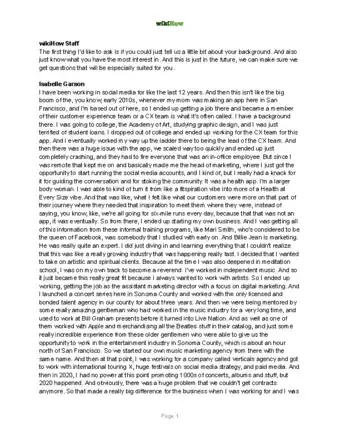
Thanks for reading our article! If you'd like to learn more about Facebook profile pictures, check out our in-depth interview with Isabelle Garson.
References
- ↑ http://smallbiztrends.com/2014/07/make-friends-on-facebook.html
- ↑ http://smallbiztrends.com/2014/07/make-friends-on-facebook.html
- ↑ http://news.discovery.com/tech/gear-and-gadgets/how-facebook-sells-your-personal-information-130124.htm
- ↑ https://www.facebook.com/help/325807937506242/
- ↑ http://www.digitaltrends.com/social-media/how-to-set-facebook-privacy-settings/
- ↑ http://www.digitaltrends.com/social-media/how-to-set-facebook-privacy-settings/
- ↑ http://smallbiztrends.com/2014/07/make-friends-on-facebook.html
- ↑ http://smallbiztrends.com/2014/07/make-friends-on-facebook.html
